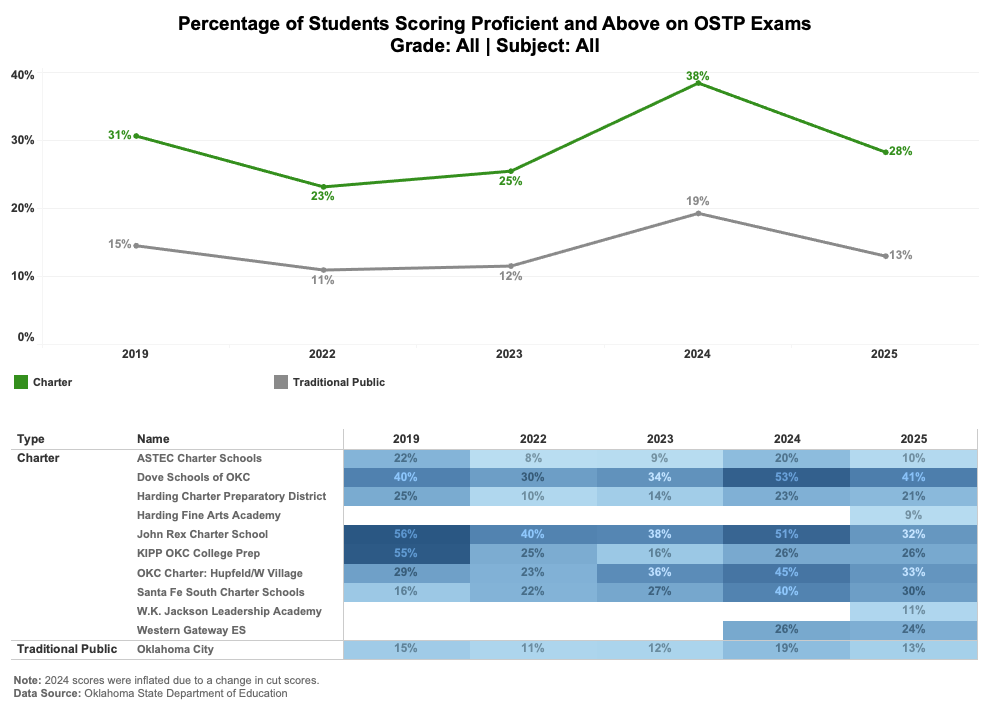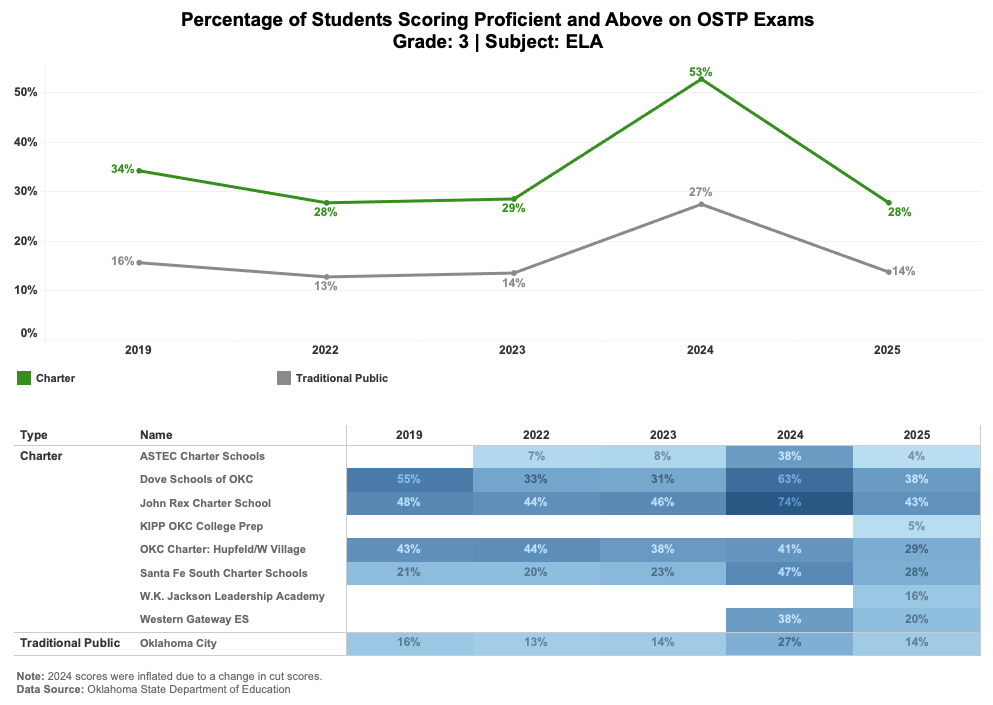2024-25 OSTP Results: Signs of Recovery, But Learning Loss Remains
Recent results from the Oklahoma School Testing Program (OSTP) for the 2024-25 school year tell a story of gradual recovery and lingering challenges for Oklahoma City students. While students are continuing to recover from the learning loss caused by the COVID-19 pandemic, proficiency rates remain below pre-pandemic levels, highlighting the ongoing challenges schools face in helping students catch up.
Pandemic Learning Loss Is Still Evident
Looking at trends over time provides a clearer picture, making the impact of the pandemic unmistakable. While comparisons to 2022 and 2023 show modest improvements, referencing 2019 — the last pre-pandemic school year — reveals the full extent of learning loss.
It’s also worth noting, while 2024 results appeared higher statewide, that year’s academic cut scores were lowered, artificially inflating proficiency rates without reflecting true college- and career-readiness. In 2025, cut scores were restored to 2023 levels, aligning with national benchmarks such as the National Assessment of Educational Progress (NAEP) and closing the “honesty gap,” ensuring that students labeled proficient are truly on track for college and career readiness.
Some Students Catching Up, Many Still Struggle
In 2025, 28% of students in Oklahoma City public charter schools scored proficient or above across all OSTP-test grades (third-eighth) and subjects — math, English Language Arts (ELA) and science. This represents steady progress from pandemic lows of 23% in 2022 and 25% in 2023, but still below the 31% proficiency rate in 2019, indicating that recovery is underway but pre-pandemic learning levels have not yet been fully restored.
Oklahoma City Public Schools (OKCPS) show a similar pattern, though with overall lower proficiency rates. In 2025, 13% of OKCPS students scored proficient or above, slightly up from 12% in 2023 and 11% in 2022. These results are still below the 15% proficiency rate recorded in 2019, highlighting the ongoing impact of pandemic-related disruptions on student learning.
A Few Bright Spots
Despite overall learning losses from the pandemic, there were notable areas of progress in Oklahoma City public charter schools. For example, 7th-grade students scoring proficient or above in English Language Arts (ELA) — reading — increased from 19% in 2019 to 23% in 2025, following lows of 13% in 2022 and 18% in 2023. Math proficiency across all grades rose from 30% in 2019 to 32% in 2025, recovering from 24% in 2022 and 27% in 2023. In 8th grade science, the percentage of students scoring proficient climbed to 41% in 2025, up from 36% in 2019, 26% in 2022 and 33% in 2023. Students in 4th, 7th and 8th grades also showed gains across all subjects tested.
Too Few Students Reading at Grade Level
However, reading proficiency remains a significant concern. Across all grades, only 24% of charter school students and 13% of OKCPS students read at a proficient level. Among 3rd graders, the numbers are similarly low: 28% of charter school students and 14% of OKCPS students are proficient readers. Reading proficiency by third grade is critical; research consistently shows that students who are not reading proficiently by this stage are far less likely to graduate high school and face long-term academic challenges.
Even the Top Schools Fall Short
Even the city’s top-performing schools consistently have 20% or fewer students scoring proficient, underscoring widespread gaps in academic achievement. A few schools are exceptions, including Dove Schools, John Rex, Stanley Hupfeld Academy at Western Village and Santa Fe South, where proficiency rates range from 30% to 41%. These outliers highlight both what is possible and how much work remains for the majority of schools.
Time for Bold Action
These test results serve as a clear call to action for education leaders. Closing persistent learning gaps will require evidence-based interventions, investments in teaching quality and a relentless focus on student learning across all grades and subjects. Otherwise, large numbers of Oklahoma City students will continue to fall behind, limiting their future opportunities and readiness for college and careers. Recovery is possible, but it will demand bold leadership, substantial resources and an unwavering commitment to high-quality instruction to ensure every Oklahoma City student has the chance to succeed.
View Fuel OKC’s interactive Oklahoma School Testing Program (OSTP) Proficiency Dashboard.


